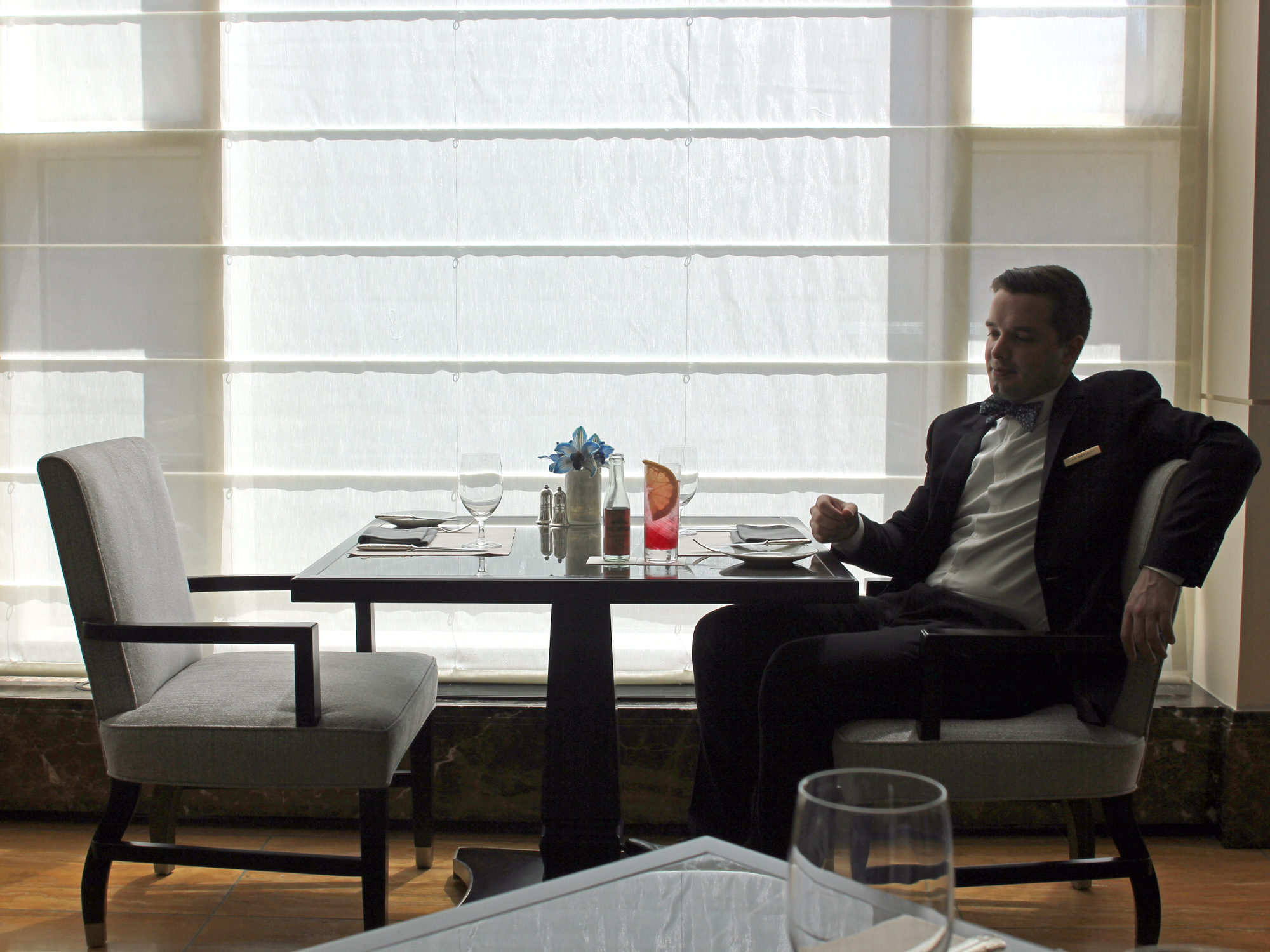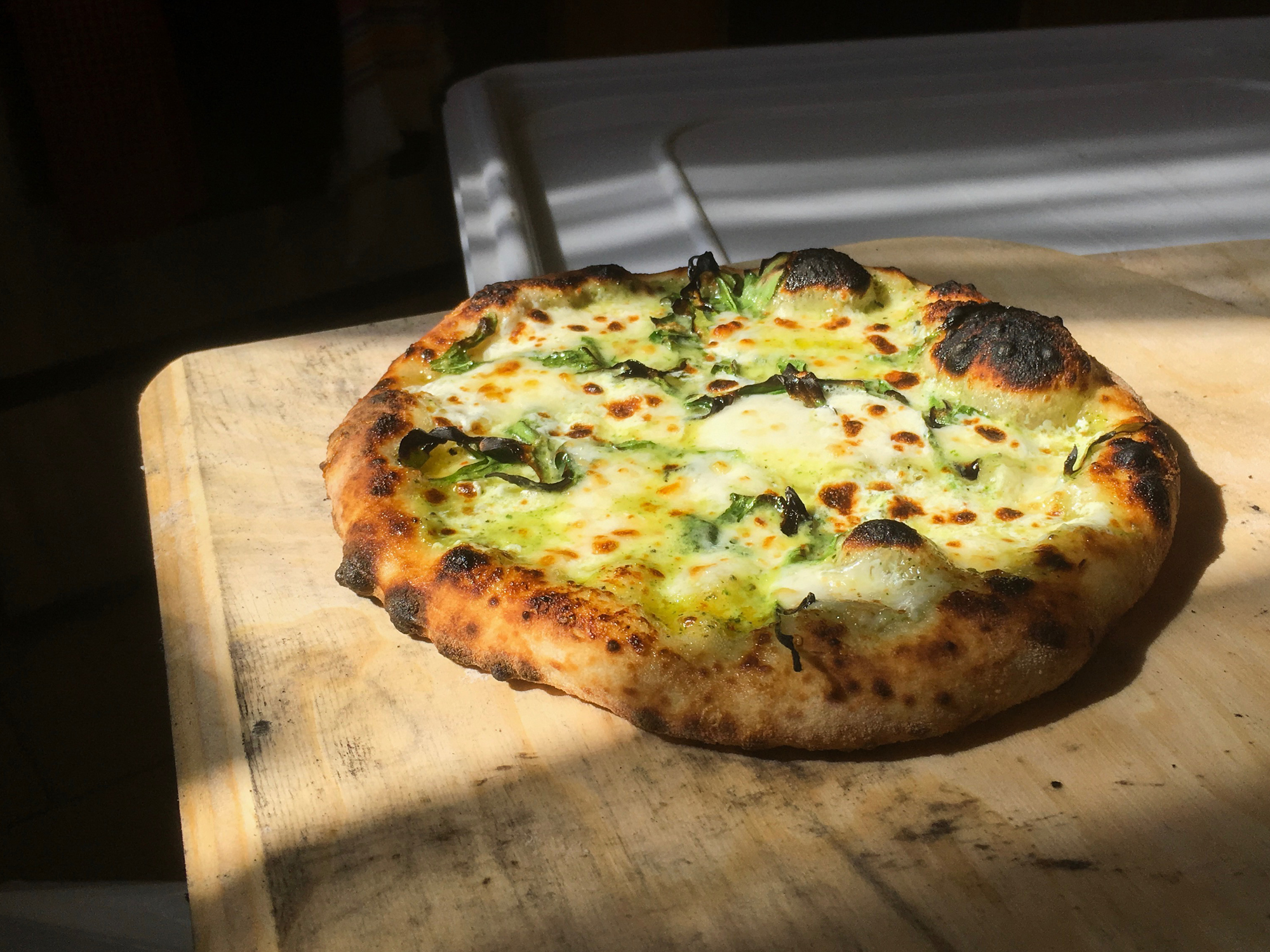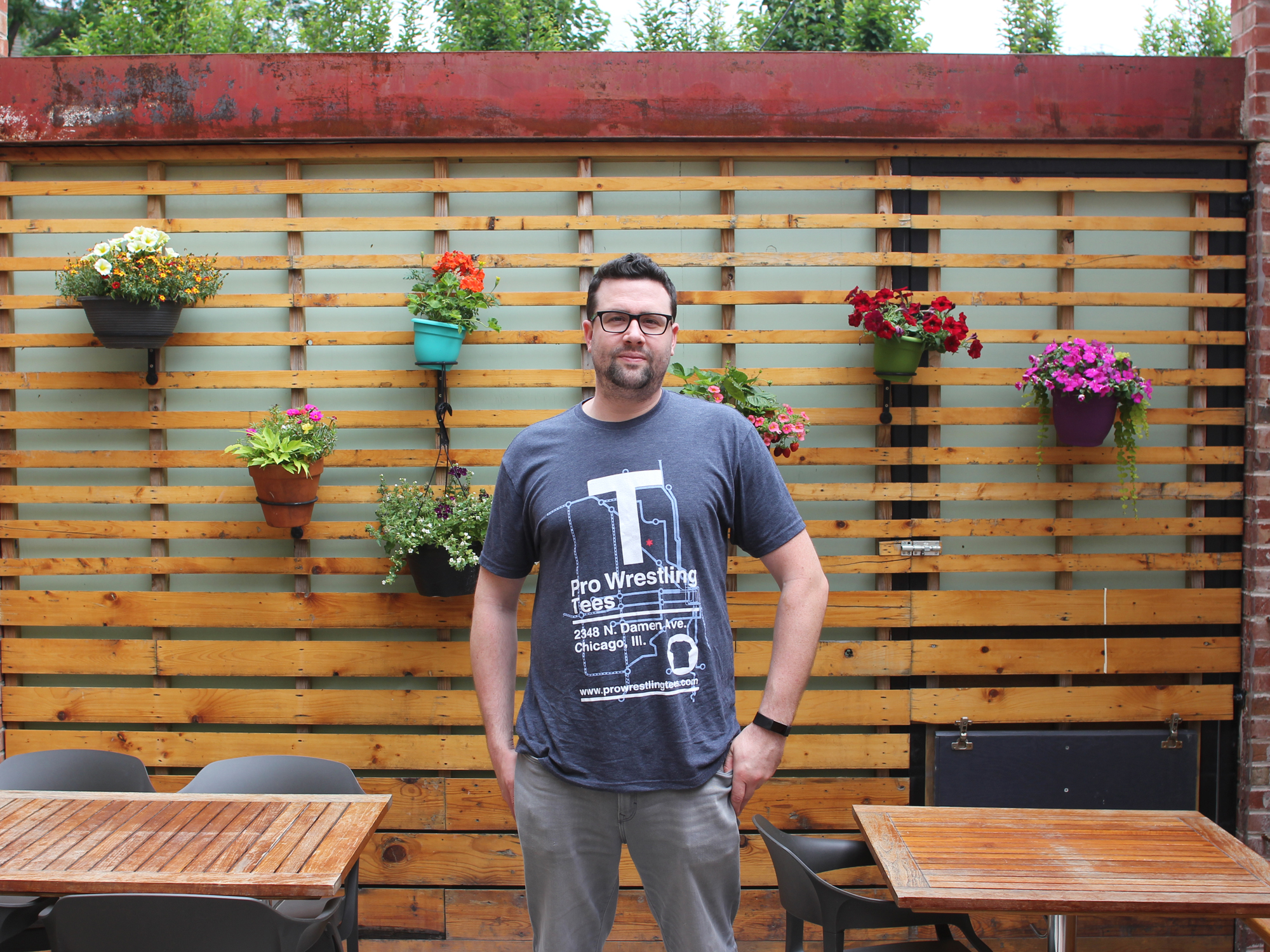A STROLL DOWN ONE STRETCH OF Milwaukee Avenue in Logan Square tells a Cinderella story from one of the neighborhood’s own. From Sawyer to Spaulding, the lively boulevard is dotted with a string of Esam Hani’s hospitality businesses—Red Star liquor store, the Walk-In, Cafe Con Leche, The Harding Tavern—representing 25 years of hard work and growth on the block.
The Logan Square veteran’s ambitious new dining venture, Saba Italian, is the latest to join the group, beckoning passersby with large attractive windows that open up to the sidewalk. Modern beats drift over twinkling ambient lighting while trendy high-tops tables covered in upscale Italian fare and innovative cocktails coax diners inside.
Relaxed at one of those high tops, Hani starts reminiscing on the energy of the area in the early ‘60s. Although he won’t go as far as to call it a golden era for the neighborhood, he remembers it as a time when pedestrians strolled the bustling avenue to peruse superstores of the era like Goldblatt’s and Woolworths.
“People would come from far out of their neighborhoods to Milwaukee Avenue to shop. As a kid growing up, it was amazing,” Hani, who immigrated to Chicago from the Middle East at the age of four, recollects. “We had a theater, we had a major department store, all these boutiques. A lot of them don’t exist anymore. It was a bustling neighborhood.”

Esam Hani at Saba
It was this childhood memory that encouraged Hani, who first opened the small Red Star liquor store in 1991 on Milwaukee Ave., to turn towards the same pocket of Logan Square for his first food business, Café Con Leche. In 2001, however, the neighborhood was unrecognizable from the busy city center he had known during his youth. Decades of gang wars and an influx of violence had given the neighborhood a seedy reputation, and it was just starting to pick its head back up.
Hani, who had left a job as a machinist to open the liquor store, says “For many years into the ‘80s and ‘90s, it was pretty gang… I don’t know if infested is the right word to use, that sounds pretty drastic. But there was heavy gang involvement in the neighborhood.”
“The stores were starting to close, a lot of the major chains were leaving, and at one point, the majority of the strip where I opened my restaurant right here, was empty,” he continues, gesturing out the window. He pauses. “I’d say 80 percent of the storefronts were empty, and it wasn’t good. It wasn’t good for anyone.”
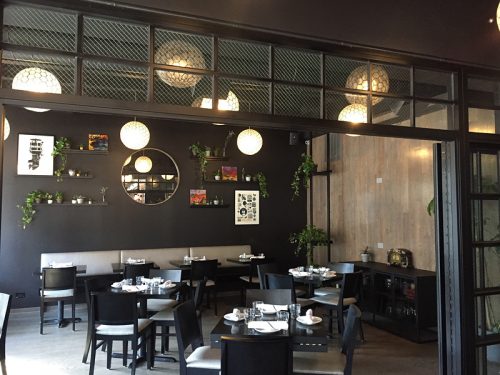
Saba Italian
LATINOS HAVE LONG BEEN THE DOMINANT racial group in the neighborhood, and made up 65 percent of the community’s total population in 2000. However, even the idea of opening a small Latin eatery—the inaugural 5-table version of Café Con Leche—on what was then a near-deserted street was met with skepticism from friends and acquaintances who lived in the neighborhood. Living only a block away from the boulevard himself, Hani felt he was starting to see the tide turn.
“When I built it, people would tell me, ‘Why are you building this?’” Hani, 56, recalls. “’You know, there’s no one here.’ And I just felt like, if you build it, they’ll come. And sure enough, we built it and they came. People came and they actually wanted it.”
It didn’t happen quite that effortlessly in real life. Five years after opening up Café Con Leche, Hani bought out his business partner and expanded the modest restaurant space into the next door area while adding a selection of dishes to the limited menu. Now open for 17 years, it’s a popular destination with locals and tourists from Latin countries.
“I’ve seen the people moving in, I’ve seen the neighbors, and I’ve seen that it was coming,” Hani says of Logan Square’s evolution. “I’ve owned property on some of these side streets, and I know who my tenants were, so I was able to see who was coming and looking at my apartments, who was renting the apartments. I know what it was when it was bad and I’ve seen the changes. I was able to get a sense of what the neighborhood was becoming because I lived it day and day out.”

Growing things
But there’s a big difference between owning a successful Latin restaurant in a neighborhood still known for its strong Hispanic presence, and drawing in locals with a trendy Italian eatery serving items like salt cod arancini and gnocchi crafted in-house from charred potato skins. It’s even more surprising for someone who emphasizes that he’s “not a restaurant guy” and that he’s never worked in a restaurant. As a local who’s lived just down for the block for years, he’s quick to slip the word “approachable” in multiple times during our conversation. It’s the business strategy that’s allowed him to thrive in the area for almost 30 years.
One thing I didn’t want to do was alienate people from the neighborhood with them thinking, “Oh, he built this beautiful place, but we can’t afford it.”
Logan Square is a prime example of gentrification in the city, and the demographics are changing. As the cost of living has skyrocketed, more Hispanic residents have moved out of Logan Square than any of Chicago’s other 77 neighborhoods in the past decade or so, according to U.S. Census Data. Last year, Chicago magazine reported via Chicago Cityscape data that Logan Square had the highest number of buildings demolished of any neighborhood pocket in Chicago in 2017, presumably to make way for high-rise buildings like the MiCa Towers at the prime intersection of Milwaukee and California.
They are there now because of the influx of trendy eateries and upscale cocktail lounges that made the area attractive to outsiders. Amidst the growth of the “up-and-coming” area, there’s the unsurprising clash between born-and-bred residents resisting gentrification and newcomers expecting trendy places to shop, eat, and entertain. As a businessman and a local, as both a source of gentrifying influences and someone feeling its pressures in the neighborhood from bigger developers, Hani has found himself trying to strike a delicate balance between the two.
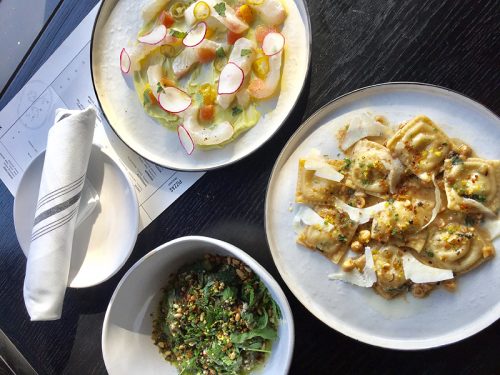
Upper left: fluke crudo with avocado and citrus; right: ravioli stuffed with parsnip and pear
EVEN AS ONE OF LOGAN SQUARE’S HOSPITALITY pioneers, Hani admits that he didn’t predict that a space like Saba Italian would do well in the neighborhood. With the commercial success of the Harding Tavern and the cocktail lounge the Walk-In under his belt, the business owner originally envisioned a fast-casual spot where theater-goers from the nearby Logan Theatre could grab a slice of pizza. His initial plans even called for the installation of a carry-out pizza window right where rows of high-top tables are now situated.
“I thought, everyone eats pizza. You can’t go wrong,” he says. His original plan was to build another pizzeria alongside current Milwaukee Ave. staples like Paulie Gee’s and Reno, but some unforeseeable hiccups led to the restaurant becoming what it is today.
Armed with two local designers for the first time (he reveals that he’s always done his own designs in the past), Hani started construction on the site, and quickly realized that it was starting to become “a pretty fancy-looking pizzeria.” A series of happy accidents further developed Saba Italian into its final form as he saw that the kitchen capabilities and space wouldn’t allow the restaurant to function as a pizzeria the way it was designed. With that idea out the window and back to the drawing board, Hani tasked general manager Meghan Heerey and Chef Mark Bestmann with bringing Saba to life as a full-fledged Italian restaurant, all while keeping things “approachable” and not distancing local customers.
So how does one juggle approachability with adventurous flavor profiles? Chef Bestmann, who hails from Boston eateries Coppa and Toro, says the neighborhood’s changing tastes have definitely helped. Plus, there is still a selection of pizzas on the menu, albeit an elevated one, including an adventurous pie topped with pea ricotta, braised lamb, and za’atar yogurt.
“I think we had the good fortune in Logan Square for being a neighborhood where a lot of restaurant industry kids live because of the affordability of this neighborhood, it being a little bit farther outside of the downtown,” Bestmann says. “There’s a certain percentage of demographic there where there’s people who are interested in trying some out-of-the-box things.”
Although Logan Square certainly boasts more than a handful of top restaurants—Fat Rice’s Abraham Conlon took home Chicago’s only James Beard Award this year, restaurants like Giant and Mi Tocaya Antojeria attract national magazine attention, and Osteria Langhe puts their own creative spin on Italian cuisine—Bestmann’s approach is to bring unique flavors to familiar dishes that you can get at any Italian mom and pop restaurant.
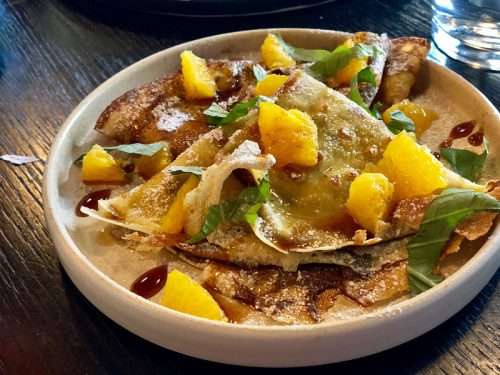
Along with the grano arso gnocchi and a mezzaluna pasta tossed with brown butter sauce and stuffed with parsnip and pear, there’s comforting favorites like spaghetti and meatballs and penne with vodka sauce. There’s even a house-made cotechino crafted from housemade sausage served with spices, braised cannellini beans, and bread crumbs—priced at just $12. Chef Bestmann cites “old-school” Italian cooking as an inspiration.
“For the cotechino, we’re getting that meat and poaching it ourselves, grinding it ourselves, and it’s just that tradition of old-school Italian where you take everything and you make the best out of it,” Bestmann says. “It’s looking at utilizing the full product, not making any waste. Like the ash from the gnocchi, using that potato skin for not only flavor, but also not wasting anything.”

Italian meets Latin: Chorizo pizza with piquillo pepper, dried figs
WHILE HANI HOPES THAT THE TRAFFIC of foodies to Logan Square continues, his emphasis is on building regulars from the local crowd. “The thing that I like about local business is that they will always support you. They’re there for you every day,” he says. “That’s our backbone. Our local foot traffic, people who live a few blocks from here. Those people will carry you through the slow days.”
In an effort to encourage familiar faces to see the spot as an all-occasions dining option, he’s made every dish on the menu under $20. “One thing I didn’t want to do was alienate people from the neighborhood with them thinking, ‘Oh, he built this beautiful place, but we can’t afford it,’” Hani says. Bestmann echoes his sentiments, adding, “For us, when we started coming from outside and building this newer program that’s not very similar to what you have in Logan Square, it’s extremely important to be a part of the neighborhood and become friends with everyone here.”
As a businessman, Hani’s focus may be first and foremost on serving approachable food that won’t intimidate customers. However, in Logan Square’s changing city-scape, it doesn’t hurt to bring creative and trendy cuisine to the table.
“It’s funny, people say, ‘I’m a foodie’ a lot these days,” Hani says. “I had a customer come in and say, ‘I’m a foodie, and I love how you have the very high-end gnocchi, but then you have something as simple as eggplant parmesan that you did at such a level that was done extremely well. You have the stuff that foodies like myself are looking for.’”
From his vantage point as a business owner, a landlord, and a longtime resident, Hani sees no end to Logan Square as a food-driven neighborhood, especially with upcoming developments in the works. He cites the planned opening of a small Target at the site of the former discount MegaMall on Sacramento and Milwaukee, as well as a 50-room boutique hotel, as driving factors for more business.
“There’s definitely a lot more density coming into the neighborhood, and I think that people are happy that they can do what they like to do in their neighborhood, and not have to leave their neighborhood,” Esam says, hinting that he has a “little more left” if the opportunity to open another business presents itself in the future.
“When I was growing up, you didn’t take the Blue Line because it wasn’t the safest thing to do,” he remembers. “I talked to a guest last week who came in from out of town on the Blue Line and felt comfortable, so there’s more accessibility. There’s the boulevards, there’s easy transportation. I think it’s going to be a very food-driven neighborhood.”
Saba Italian’s success from locals “excited to see a place like this in the area” seems testament to that. Even today, this pocket could be the bustling Milwaukee Ave. he describes from his childhood.
“My vision was to build some kind of pizza concept,” Hani says, laughing. “The original concept of the restaurant to where it is today… is night and day. And I couldn’t be happier.”
Lara Walsh is a journalist who’s written for Elite Daily and InStyle Magazine. When she’s not avidly planning her next trip, she’s writing for her travel food blog The Hungry Babe Travels or mapping out her next foodie adventures in Chicago with @thechicagofoodies.
Latest
Join the Discussion
After you comment, click Post. If you're not already logged in you will be asked to log in or register with Disqus.





